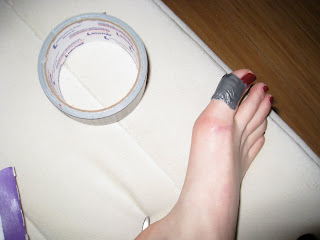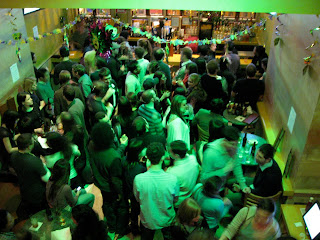Yesterday was the final day of the symposium. (I didn´t write up a summary last night because it had been decided already that today would be a snow day and I went out to celebrate that fact. Pictures of a snowy Columbia campus coming soon!) The keynote speaker, who works in DC, was unable to get out of the city because of the weather down there, and the techies were having some trouble getting the video feed set up for her, so we began with what was supposed to be the second session. I really liked the concept; there were three professors of history who talked about educational policy throughout US history, with an emphasis on the last 50 or so years. It was pretty interesting. Their most salient points (in my professional opinion): Whereas, in one speaker's opinon, the focus of educational reform under G. W. Bush was graduation from high school, the focus of the Obama campaign is the transition from high school to college/career; a hallmark of educational reform is that it tends to overestimate the impact it will have while underestimating the difficulty of implementation (d'oh!); the media, however, doesn´t often compare the specific goals of a reform with the specific outcome to prevent people from becoming cynical - rather they just sort of deplore the general inadequacy of the education system; specific curricula/commercial programs to assist with math, literacy, etc. aren't clear-cut successes or failures because they work well in some environments and not in others. After their spiel, there was an opportunity for questions. One guy, probably the oldest in the room, let loose a 5-minute tirade before asking his question. Initially, I was interested in what he was saying, but I lost interest after the first few minutes. He said that the incentive of money (or the threat of not receiving money) from the federal government was sometimes the only thing that would persuade states to reform their educational systems. As proof of this theory, he brought up the subject of desegregation. After the
Brown case, many districts in the South refused to start busing until the federal government threatened to withhold funding, which, in his opinion, was the only reason they ended up making the change. Interesting point.
Our keynote speaker, Russlyn Ali, was finally able to connect with us via Skype. She's the assistant secretary in the Office of Civil Rights and has quite a laundry list of credentials even though she looks only about 30. She was a very inspirational speaker, and when she talked about fighting for disadvantaged children and inadequate schools, she looked like she was on the verge of tears. She talked about the importance of accurate data collection so that negative trends can be identified and remedied, and about the importance of using stimulus funds to creat long-term changes rather than plugging budget holes. I liked a lot of what she had to say, and I really liked the fact that she had teaching experience. (Her post doesn't directly affect educational policy, but I always like elected officials who have any influence in education at all with experience in classrooms; many of them, including our SECRETARY OF EDUCATION have never taught before.) However, she was clearly a politician, and that became clear during the question-and-answer session that followed her speech, during which she expressed deep concern for the issues raised by the questioners and then failed to provide a single solid answer to any of them. Her mantra: "stay tuned, we're working on it."
The next session focused on law, and featured the heads of two watchdog committees centered on education and a lawyer-turned-professor whose specialty at Columbia Law School is educational law. This was my favorite session of the day. I learned something I think few people know: Financial hardship is not considered a legal excuse for states to provide substandard education. By law, if a state is in dire straits and a governor has to make budget cuts, he cannot cut money from education if it means that children will receive services that are not considered adequate. The shrewd thinker will quickly see the problem here, though: It's pretty hard to nail down just what factors must be present in a school if it is to provide the kind of education that is guaranteed by law. Still, it would be a great excuse for an education-minded governor faced with a tight budget to make cuts in other areas rather than slashing education funds. On the topic of cutting costs, one of the speakers talked about a lot of areas that are pretty inefficient financially. He said that there is generally a lot of waste in transportation, and lots of heads in the audience bobbed in agreement. (For an interesting transportation-themed anecdote, scroll down*.) He said also that multi-year budgeting was generally much more streamlined than year-by-year budgets and that small school districts could save huge amounts of money by consolidating into larger districts; he admitted, during questioning, that this isn't always an appropriate course of action, however. His final proposal was that teacher pensions need to be drastically cut, in New York at least. Naturally, I bristled at this, but after he'd explained himself I found myself agreeing with what he had to say. He talked about teachers who retire when they're 55. Life expectancies being what they are, that leaves the district with around 25 years to keep making payments to the "retiree," who, odds are, will pick up another job to fill all of that free time and end up with two incomes (this does happen, apparently; he wasn't just being snarky). In addition, until the retiree turns 65, the school district is responsible for 100% of his/her medical bills before MedicAid takes over. Ouch. That's a lot of money. The speaker, who was no spring chicken himself, said that society in general provides a lot of resources for older people when it should be focusing on the younger generations. Although I've left the younger-generation category, I guess I agree...
I attended a discussion over lunch during which two women, one from Italy and one from the Netherlands, talked about educational funding in their respective countries. It was fascinating to compare their systems with ours, and it got me interested in other funding systems in foreign school systems. Luckily, I have enough friends abroad that I can look into this further. I've sent out some emails and will most likely write an entry later detailing what I learn.
The final session of the day was a little slow. It was called "State and Federal Perspectives." I took few notes and left before it was over; it just didn't seem cohesive. The only point that really hit home for me was when one of the speakers, talking about standards and testing, pointed out that it didn't seem fair that kids be expected to achieve the same amount if they don't have the same amount.
I'll finish with a few questions raised by the symposium that have left me thinking. I don't suppose there are really answers, but I'll pose them here, and if you have a solution, pass it on!
-According to the Constitution, what exactly are students guaranteed to receive in public schools? Services? A certain outcome? An opportunity?
-What are the mandatory criteria of a basic, appropriate education? What can be cut? What absolutely has to stay?
-To what extent is consolidation (of standards, curriculum, school governance, etc.) a good thing? Does it lead to school/district/state empowerment, or impotence?
-Related: What role, if any, should the federal government have in public education?
*Transportation anecdote: Courtney and I were talking recently about an interesting policy in New York public schools. Students, regardless of where they live, are allowed to apply to any junior high school/high school in the city. Ultimately, it is the school's decision to admit individual students, but the theory is that families have a shot at avoiding schools with bad reputations. This is supposed to create competition among the school so that they'll try to be better to attract more students, because schools with lower enrollments get less funding. One of Courtney's co-workers in Boston used to teach in New York and she told us about how smart the kids are in this city (although I don't think their teachers taught them about this particular trick): If a child is admitted to a school that's a certain distance away from his/her home, the district issues a monthly subway pass so the kid can get to school each day. Monthly passes allow for unlimited use for a 30-day period and cost somewhere around $60. (They may be cheaper for children; I haven't looked into it.) These bright youngsters would hang out with their passes in busy stations like Grand Central and Times Square and offer to swipe people through the turnstiles for $1. The kid would pocket the money, the traveler would save $1.25 off the price of a ticket, and the city would lose the $2.25 it should have collected. I don't think this is exactly what the speaker meant when he talked about inefficient transportation budgets, but it would probably qualify.





























